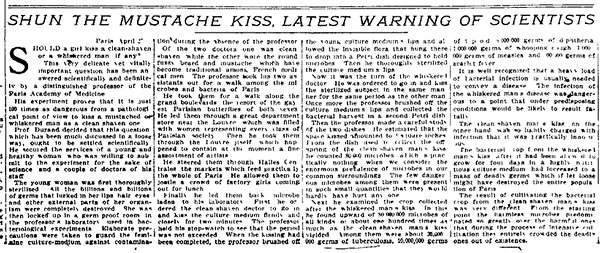Experiments
Music-Impregnated Milk
In this 1910 experiment, nine musicians played the "Blue Danube" waltz and other selections while farm hands milked 61 Jerseys and Holsteins.The result: "The music calmed the nerves of the cows and their udders let down all the milk in them." Also, this milk "tasted better and had a more happy effect upon the drinkers than the milk served which had not been 'music impregnated.'"
Why aren't the upscale food stores of today (like Whole Foods) selling music-impregnated milk? I'm sure there are people who would spend the extra money for it.

Source: The Louisiana Comrade - Aug 26, 1910; also printed in the Red Lake Falls Gazette (1910).
Posted By: Alex - Sat May 09, 2015 -
Comments (3)
Category: Animals, Food, Music, Experiments
Concussion Test
1958: Dr. Henry Montoye of Michigan State University studied the shock resistance of football helmets by having players wear the helmets and then dropping weights on their head. Try getting approval to do that experiment today! Source: Life - May 19, 1958
Posted By: Alex - Sat Apr 04, 2015 -
Comments (4)
Category: Experiments, 1950s
Erismann and Kohler: Inversion Goggles
"The movie documents a classic experiment conducted in 1950 by Ivo Kohler and Theodor Erismann at the university of Innsbruck, Austria. Erismann is the older person the movie, and Kohler, his research assistant at that time, is the person wearing the inversion goggles. Subtitles are all in German."
Full story here.
Posted By: Paul - Sun Mar 15, 2015 -
Comments (2)
Category: Science, Experiments, 1950s, Eyes and Vision
Eye Test

These two pictures are part of a science experiment. The tractor has been replaced by an octopus. What is being measured?
Answer after the jump.
More in extended >>
Posted By: Paul - Sat Nov 29, 2014 -
Comments (7)
Category: Science, Experiments, 1970s
Shun the Mustache Kiss!
We're now three weeks into Movember. So this seems like timely advice from the Washington Post - Apr 28, 1912.


Posted By: Alex - Tue Nov 25, 2014 -
Comments (3)
Category: Hygiene, Experiments, 1910s, Hair and Hairstyling
Virtual Reality Experiment
UK artist Mark Farid wants to spend 28 days wearing virtual reality goggles, and he wants all of us to pay for it. His plan is that by wearing the goggles he will "experience life through another person's eyes and ears." This person whose life he'll be experiencing is only known as "The Other."Farid is raising money on Kickstarter to make this plan a reality, and he figures he can do it for £150,000. That's around $235,000.
Why so much? Because, says Farid, the experiment "will require a team of medically trained invigilators at all times over the course of the 28 days as well as camera men, technicians and assistants on site 24 hours a day. This means sleeping accommodation and amenities must be provided for them onsite."

Posted By: Alex - Wed Nov 19, 2014 -
Comments (6)
Category: Art, Performance Art, Experiments
Alchy the alcoholic hamster
Back in 1958, high-school sophomore Diana McGee chose as her biology project an experiment "to make a hamster an alcoholic, then to cure it of the disease." She named the hamster "Alchy". The hamster consumed about a pint of bourbon a month and reportedly "seems to love it." Unfortunately, the news report never followed up on whether McGee was able to cure her hamster of his habit. Nor did it reveal what grade McGee got for her project.Source: The Salina Journal (Salina, Kansas).
Update: I actually spoke too soon about the lack of a follow-up. Another search revealed that the Salina Journal did report on Apr 25, 1958 that Alchy eventually refused to drink any more of the bourbon-water mixture, leading the paper to comment that "the animal has more sense than some people."

Posted By: Alex - Fri Jun 06, 2014 -
Comments (4)
Category: Animals, Inebriation and Intoxicants, Experiments
Kate Smith, the flag-raising rat

Kate Smith was a rat trained to raise a small American flag. It was trained by Kelly Buckwalter of Santa Barbara High School as "an experiment in operant conditioning" for her chemistry and psychology classes.
Do kids still get to do experiments like this in high school? Somehow I doubt it. Source: The Tuscaloosa News - May 22, 1976.
Posted By: Alex - Sat May 24, 2014 -
Comments (4)
Category: Animals, Science, Experiments, Psychology, 1970s
Cold Outside
Where Fahrenheit and Celsius meet, -41 degrees, is the temperature folks were enduring on the second day of the new year in northern Ontario, Canada. One person decided to amuse themselves with the weather by shooting boiling water out of a super soaker into the frigid air. The effect is rather cool.
Posted By: Alex - Mon Jan 06, 2014 -
Comments (9)
Category: Experiments
Dead mice dropped from helicopters
Over in Guam, researchers are dropping dead mice out of helicopters. The idea is that the mice, which have been doped up with acetaminophen, will land in trees and be eaten by snakes. The snakes will then die, because acetaminophen is poisonous to them. It's an experiment to see if this method will work at reducing the snake population, which is growing out of control. The video shows some of the mice falling from the skies. [NPR]
Posted By: Alex - Mon Dec 16, 2013 -
Comments (12)
Category: Science, Experiments

| Who We Are |
|---|
| Alex Boese Alex is the creator and curator of the Museum of Hoaxes. He's also the author of various weird, non-fiction, science-themed books such as Elephants on Acid and Psychedelic Apes. Paul Di Filippo Paul has been paid to put weird ideas into fictional form for over thirty years, in his career as a noted science fiction writer. He has recently begun blogging on many curious topics with three fellow writers at The Inferior 4+1. Contact Us |




